
Mexico.- The “Mexican Miracle” is known to the economic model in Mexico in the approximate period between 1954 and 1970, which sought to achieve economic stability for the sustainable and continuous development of the country. During this period Mexico had three presidents: Adolfo Ruiz Cortines (1952-1958), Adolfo López Mateos (1958-1964) and Gustavo Díaz Ordaz (1964-1970).
This period also coincided with the transit of rural Mexican society to an industrialized urban. The government’s measures were liberal in nature, which would bring better benefit to society, rather than government assistance.
Image of Mexico City ? Special
The economic premise during the “Mexican Miracle”, also known as “Stabilizing Development”, was the philosophy of removing economic barriers such as inflation, devaluations or the deficit in the balance of payments. This brought about macroeconomic stability and continued growth. This period, which lasted 18 years, had sustained economic growth of 6.6% per year and inflation of 2.2%. This, due to modern industrialization and the expansion of the domestic market, urban growth and land reform.
Mexico’s President MIguel German (left) with Harry Truman, US President U.S. (1947) – Source: National Archives and Records Administration [Public domain]
The “Mexican Miracle” involved a multiple sectors of society in a common project: “the government guaranteed bankers, workers, entrepreneurs and peasants high rates of profitability if they committed to interning abundantly in the country. That’s why the government made a tax cut and promised to save broken companies. Stabilizing Development Goals
Raise the quality of life of the population, especially the most unprotected, peasants, workers and middle-class sectors.
Continue to increase national income.
Accelerate the process of diversifying productive activities in the economy.
Advance the expansion process by giving preference to the basic industries.
Make better use of national financial resources through proper coordination of monetary, fiscal and credit policies.
End of the Mexican Miracle
This period saw its end in 1970, despite the advances of the “Mexican Miracle”. Mexicans suffered high inflationary levels (with a cap of 18%), and industrial production reached a limit on the implementation of the import substitution policy. This fell to a social deficit, so the state increased public spending and stalled the ingren able to. In this way, the crisis of 1976 was created: huge external debt, contraction of private investment and a devalued currency. With Concepto.de information
Original source in Spanish
"El reclamo puede ser genuino, pero construido sobre una mentira", apuntó el presidente Javier Milei…
El gobernador de la provincia de Buenos Aires, Axel Kicillof, encabezó un acto en Ensenada…
El diputado nacional de La Libertad Avanza, José Luis Espert, expresó su confianza en la…
Tras la masiva reaparición de Cristina Fernández de Kirchner, el presidente Javier Milei apuntó contra…
El principal propósito de la nueva comisión es evaluar los recursos humanos en el Senado,…
En una medida que busca redefinir las condiciones de los seguros de automóviles en Argentina,…
Esta web usa cookies.